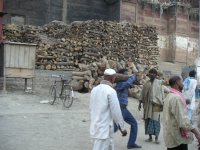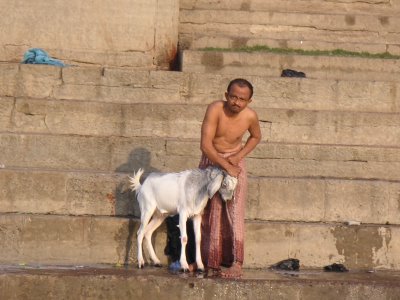I Think It's Pronounced Gan-ga, not Gan-ja... (India)

End of February, 2006
On the way to Varanasi I had to stop for a few hours in Delhi to change trains, and took the subway from Old Delhi station to New Delhi to hang out in the Paharganj area for a bit. My first "Delhi Experience" was quite an unexpected one. The subway system was new, orderly, clean, quiet, hassle-free, it didn't smell of anything, men weren't spitting everywhere and there were no cows. Quite an un-Indian experience!
The second "Delhi Experience" was a bit more on the expected side. When I surfaced at New Delhi I had to negotiate the maddest, thickest, noisiest concentration of people, vehicles and animals I have ever encountered in India, including one bus trying to execute a three-point turn in a busy narrow street by nudging the pedestrians and street traders on either side of the road. I stood, watched and re-confirmed my belief that these people are all quite mad.
 Having got myself into Paharganj un-nudged by bus, tuk tuk or any other vehicle, it was a nice surprise to bump into Max again. He was in Delhi to oversee having a Royal Enfield motorbike built from scratch. Enfields are classic old Indian bikes, and even someone like me who has no interest in motorbikes can't help but admire their old-school style. After it has been built, he's riding it up through Pakistan, Iran and all the way back to Norway. Now that's a trip!
Having got myself into Paharganj un-nudged by bus, tuk tuk or any other vehicle, it was a nice surprise to bump into Max again. He was in Delhi to oversee having a Royal Enfield motorbike built from scratch. Enfields are classic old Indian bikes, and even someone like me who has no interest in motorbikes can't help but admire their old-school style. After it has been built, he's riding it up through Pakistan, Iran and all the way back to Norway. Now that's a trip! So I left after a few hours on another overnight sleeper to arrive in Varanasi the next morning. Varanasi is probably the holiest city in India, and activities are centred on the Ganga (Ganges) River that flows through it. The river has many religious roles, but the main one is that of disposal of the dead. For Hindus, Varanasi is a most auspicious place to come to die as you can then be cremated on the banks of the Ganga.
So I left after a few hours on another overnight sleeper to arrive in Varanasi the next morning. Varanasi is probably the holiest city in India, and activities are centred on the Ganga (Ganges) River that flows through it. The river has many religious roles, but the main one is that of disposal of the dead. For Hindus, Varanasi is a most auspicious place to come to die as you can then be cremated on the banks of the Ganga.At certain ghats, (sets of steps down to the water), bodies are burnt on funeral pyres. On the day I arrived, I took a walk along the river and watched activities at "the burning ghats" for a while, (which is OK, but no photos of the pyres of course). Although the cremation is a ceremony, here was very little that was ceremonial about is as far as I could see, and the whole process had quite a shocking matter-of-factness about it. I guess the realities of completely and properly burning a human body using only wooden logs mean that you have to be quite practical about it.
 Men of the lowest caste administer the pyres, as only they are allowed to touch the dead. The body arrives at the ghat wrapped in an ornate shroud, and is placed on top of a pile of logs. Further logs are then placed on top of it, and more ornate cloth is then stuffed into the pile at the bottom to act as kindling. There are huge stocks of logs just by the ghats, as the cremations are a continual business during daylight. Several pyres are on the go at any one time, and when I was watching there were several at different points of building and burning.
Men of the lowest caste administer the pyres, as only they are allowed to touch the dead. The body arrives at the ghat wrapped in an ornate shroud, and is placed on top of a pile of logs. Further logs are then placed on top of it, and more ornate cloth is then stuffed into the pile at the bottom to act as kindling. There are huge stocks of logs just by the ghats, as the cremations are a continual business during daylight. Several pyres are on the go at any one time, and when I was watching there were several at different points of building and burning.One was in quite an advanced stage of combustion, and when I looked at it I couldn't make out anything being burned other than logs. However one of the men came over and gave the pyre a good stoke, and it was only then that I recognised the shape of a human torso and head, charred completely black except for some ribs sticking out of the chest. Apparently the only bits that don't burn at temperatures achievable on a log fire are the ribs and sternum of a man, and the pelvis of a woman, since the bone is too thick.
The ashes and any unburned bits are thrown into the Ganga. Also, there are some types of bodies that are not cremated, such as babies or smallpox victims. These bodies are simply placed in the river and carried away by it, (until of course they drift ashore a bit further downstream). Apparently at one point flesh-eating turtles were introduced to the Ganga to assist in the disposal process, but they died.
 However, the river has other uses, and like any other river in India people bathe in it, brush their teeth with it, do their laundry in it, wash their animals in, as well as drinking straight from it. But it's not just the funeral activities that make this a strange idea to Western minds; there is also the upstream industrial pollution, not to mention the direct dumping of sewage from the city itself right into the river. It says two things about the Indians who use the Ganga: that they have incredibly tough physical constitutions not to get sick from it, and that their faith as Hindus must be incredibly strong to lead them to revere such a dirty, fetid body of water.
However, the river has other uses, and like any other river in India people bathe in it, brush their teeth with it, do their laundry in it, wash their animals in, as well as drinking straight from it. But it's not just the funeral activities that make this a strange idea to Western minds; there is also the upstream industrial pollution, not to mention the direct dumping of sewage from the city itself right into the river. It says two things about the Indians who use the Ganga: that they have incredibly tough physical constitutions not to get sick from it, and that their faith as Hindus must be incredibly strong to lead them to revere such a dirty, fetid body of water.After seeing the ghats, I took a cycle rickshaw back to the hotel through streets clogged with celebrations for a religious festival. The driver kept having to take alleyway detour after alleyway detour to avoid the blockages, so having bargained hard at the start for a reasonable price I tipped him for all the extra effort! Nothing stops the religious celebrations - in fact they stop the city if need be.
 The next day I took a 6 a.m. boat trip down the river with other people from my hotel: Lawrence and Nina from Leeds, (avid 6 Music listeners! They want more Aphex Twin and Cooper Temple Clause, please....), and a Canadian. The light was fantastic at that time, and made it well worth getting up at 5 a.m. Lawrence, an affable landscape gardener, puffed on a fat joint during the boat trip to "enhance his cultural experience" and kept referring to The Ganga as "The Ganja". His girlfriend corrected him, but I think he quietly preferred his own way of saying it....
The next day I took a 6 a.m. boat trip down the river with other people from my hotel: Lawrence and Nina from Leeds, (avid 6 Music listeners! They want more Aphex Twin and Cooper Temple Clause, please....), and a Canadian. The light was fantastic at that time, and made it well worth getting up at 5 a.m. Lawrence, an affable landscape gardener, puffed on a fat joint during the boat trip to "enhance his cultural experience" and kept referring to The Ganga as "The Ganja". His girlfriend corrected him, but I think he quietly preferred his own way of saying it....So after a day and a half in surreal, holy Varanasi, I got another overnight train back to chaotic, crazy Delhi......

Post Script. On 7th March, not long after I had visited Varanasi, two bombs were detonated simultaneously at a train station and a Hindu temple in the city, killing 14 people and injuring 105.


2 Comments:
Feel the need to point out a couple of things about pollution in the Ganges:
1. Of course the locals get sick from it! They may be used to drinking crap but that doesn't mean it doesn't affect them ... Lots of them die, especially old people and children.
2. Using it anyway isn't a matter of very strong faith. The ones doing their washing and brushing their teeth in it simply don't have an alternative water source - if they did, they'd use it!
That's what happens to poor people who live in superexploited countries. Worth remembering that lots of the companies doing the polluting there are British or American chemical companies, like the ones responsible for the Bhopal chemical disaster. These companies set up over there precisely because the workforce is cheap, they can get away with chucking out lots of nasty chemicals and they don't have to bother with expensive nonsense like health and safety in the workplace. And with the money they make they can become more rich and powerful and even better able to bribe and bully poor exploited countries into letting them ride roughshod over local regulations.
Comrade Joti!
I am, as ever, humbled by the clarity and all-encompassing breadth of your world view! You are of course right about Union Carbide, (and others), exploiting cheap labour in poorer countries and screwing the local environment while they're at it. You are also right that diseases from unclean water, such as cholera, kill many poor people in less well-off nations.
However, I do think it is remarkable that more people don't get ill from this water source, given the number of people that use it on a daily basis. That comment was more of a biological musing on my part than anything else. But you are wrong about not everyone having a choice.
Remember that Varanasi is a major pilgrimmage centre for Hindus, and therefore many of those bathing in and drinking the river water have CHOSEN to do so, and in many cases have travelled great distances and spent considerable sums of money to do so. That shows incredible devotion to their faith, mais non?
Love bdgr.
Post a Comment
<< Home